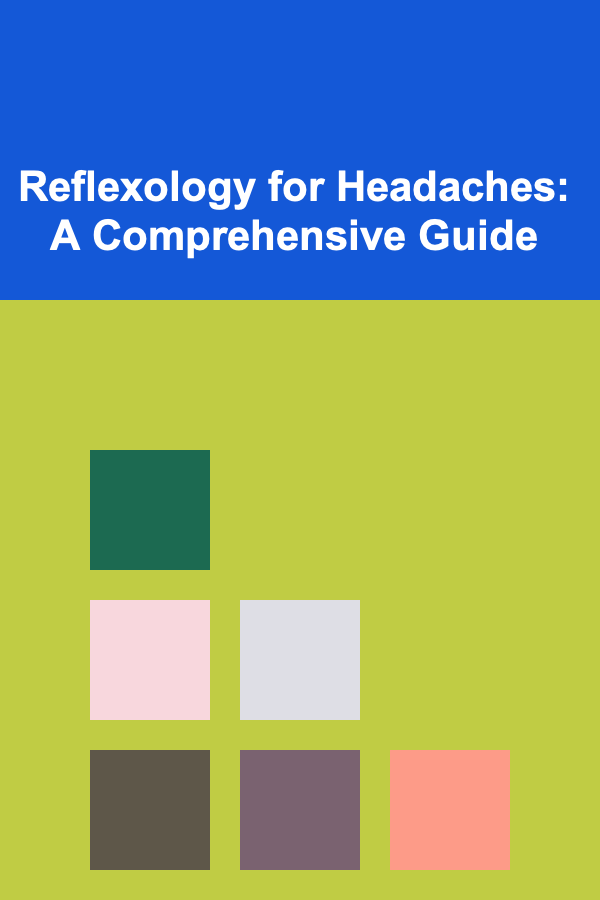
Reflexology for Headaches: A Comprehensive Guide
ebook include PDF & Audio bundle (Micro Guide)
$12.99$11.99
Limited Time Offer! Order within the next:

Headaches are a common ailment affecting millions of people worldwide. While medication often provides relief, many individuals seek alternative and complementary therapies to manage their headaches. Reflexology, an ancient practice that involves applying pressure to specific points on the feet, hands, and ears, has emerged as a promising natural approach for headache relief. This comprehensive guide delves into the principles of reflexology, its potential benefits for headaches, the specific points to target, techniques to employ, and considerations for safe and effective practice.
Understanding Headaches
Before exploring reflexology, it's crucial to understand the different types of headaches and their underlying causes. Headaches are broadly classified into two categories: primary and secondary.
- Primary Headaches: These are not caused by an underlying medical condition and include tension headaches, migraines, and cluster headaches.
- Secondary Headaches: These are caused by an underlying medical condition such as sinus infections, high blood pressure, or head injuries.
Tension headaches are the most common type, often described as a tight band or pressure around the head. Migraines are characterized by intense throbbing pain, often accompanied by nausea, vomiting, and sensitivity to light and sound. Cluster headaches are severe, debilitating headaches that occur in clusters, typically around one eye or temple.
Understanding the type of headache you experience is essential for determining the most appropriate treatment approach, including whether reflexology is a suitable option. If headaches are frequent, severe, or accompanied by other concerning symptoms, consulting a healthcare professional is crucial to rule out any underlying medical conditions.
The Principles of Reflexology
Reflexology is based on the principle that specific points on the feet, hands, and ears correspond to different organs, glands, and systems in the body. These points, known as reflex points, are believed to be connected to the body's energy pathways or meridians. Applying pressure to these reflex points is thought to stimulate the corresponding organs and systems, promoting relaxation, reducing stress, and improving overall well-being.
The underlying mechanism of reflexology is not fully understood, but several theories have been proposed. One theory suggests that stimulating reflex points triggers the release of endorphins, the body's natural pain relievers. Another theory proposes that reflexology improves blood circulation and lymphatic drainage, facilitating the removal of toxins and promoting healing. A third theory suggests that reflexology works by stimulating the nervous system, helping to balance the body's functions and reduce pain signals.
Regardless of the exact mechanism, many people find reflexology to be a relaxing and effective way to manage various health conditions, including headaches. It is important to note that reflexology is not a substitute for conventional medical treatment, but it can be a valuable complementary therapy.
Reflexology and Headaches: What the Research Says
While anecdotal evidence suggests that reflexology can be helpful for headaches, the scientific evidence is still emerging. Several studies have investigated the effectiveness of reflexology for headache relief, with mixed results.
Some studies have shown that reflexology can significantly reduce the frequency, duration, and intensity of headaches, particularly tension headaches and migraines. These studies often compare reflexology to placebo or standard medical care and find that reflexology provides a significant improvement in headache symptoms.
However, other studies have not found a significant difference between reflexology and placebo. These studies may have methodological limitations, such as small sample sizes or lack of standardization in the reflexology techniques used. More rigorous research is needed to fully understand the effectiveness of reflexology for headaches.
Despite the mixed findings, many healthcare professionals and individuals believe that reflexology can be a beneficial complementary therapy for headache management. The potential benefits include:
- Pain Relief: Reflexology may help to reduce headache pain by stimulating the release of endorphins and promoting relaxation.
- Stress Reduction: Headaches are often triggered by stress, and reflexology can help to reduce stress and tension, thereby preventing headaches.
- Improved Circulation: Reflexology may improve blood circulation to the head and neck, reducing muscle tension and promoting healing.
- Improved Sleep: Headaches can disrupt sleep, and reflexology may help to improve sleep quality, reducing the frequency and severity of headaches.
Even if the scientific evidence is not conclusive, the potential benefits of reflexology for headaches make it a worthwhile consideration for those seeking natural and complementary therapies.
Key Reflexology Points for Headaches
Several reflexology points are believed to be particularly effective for relieving headaches. These points are primarily located on the feet, hands, and ears. Here's a breakdown of some key points and how to locate them:
Foot Reflexology Points
- The Big Toe (Head): The entire big toe corresponds to the head and brain. Applying pressure to the top, sides, and bottom of the big toe can help to relieve headache pain and improve mental clarity. Pay particular attention to the area around the toenail bed.
- The Base of the Big Toe (Neck): The area at the base of the big toe, where it connects to the foot, corresponds to the neck. Applying pressure to this area can help to relieve neck tension, which often contributes to headaches.
- Solar Plexus: This point is located on the sole of the foot, approximately in the center of the arch. It corresponds to a nerve center in the abdomen and is often associated with stress and anxiety. Applying pressure to this point can promote relaxation and reduce stress-related headaches.
- Adrenal Glands: These points are located on the sole of the foot, slightly above the waistline area (approximately mid-arch). The adrenal glands produce hormones that regulate stress response. Stimulating these points can help the body manage stress and reduce headache frequency.
- Sinus Points: These points are located on the toes, just below the toenails. They correspond to the sinuses in the head. Applying pressure to these points can help to relieve sinus pressure and congestion, which can trigger sinus headaches.
- Liver Point (Right Foot): Located on the sole of the right foot, this point helps to detoxify the blood. Stimulating this can help alleviate headaches caused by toxin buildup.
Hand Reflexology Points
- Thumb (Head): Similar to the big toe, the thumb corresponds to the head and brain. Applying pressure to the top, sides, and bottom of the thumb can help to relieve headache pain.
- Base of the Thumb (Neck): The area at the base of the thumb, where it connects to the hand, corresponds to the neck. Applying pressure to this area can help to relieve neck tension.
- Solar Plexus: This point is located in the center of the palm, approximately where the lifelines intersect. Applying pressure to this point can promote relaxation and reduce stress.
- Sinus Points: These points are located on the fingers, just below the fingernails. Applying pressure to these points can help to relieve sinus pressure and congestion.
Ear Reflexology Points (Auriculotherapy)
- Shen Men (Spirit Gate): Located in the upper triangle fossa of the ear, this point is known for its calming and pain-relieving properties.
- Point Zero: Located in the center of the concha cavity, this point is believed to harmonize the body.
- Brain Point: Located in the upper part of the ear lobe, stimulating this area can help alleviate headache pain.
Reflexology Techniques for Headache Relief
To effectively use reflexology for headache relief, it's important to learn the correct techniques. Here are some basic techniques you can use:
- Thumb Walking: This technique involves using the thumb to apply pressure and move along the reflex point in a "walking" motion. Apply firm, steady pressure and move slowly, covering the entire area of the reflex point.
- Finger Walking: Similar to thumb walking, this technique uses the index finger or middle finger to apply pressure and move along the reflex point.
- Point Work: This technique involves applying direct pressure to a specific reflex point using the thumb or fingertip. Hold the pressure for several seconds, then release. Repeat several times.
- Rotation: Apply pressure with your thumb or finger and gently rotate in a small circular motion over the reflex point.
- Kneading: Use your thumb and fingers to gently knead the area around the reflex point. This can help to release tension and improve circulation.
When applying pressure, it's important to listen to your body. Apply firm, but not painful, pressure. If you experience any discomfort, reduce the pressure or stop the treatment. Focus on breathing deeply and relaxing while performing reflexology.
A Step-by-Step Guide to Performing Reflexology for Headaches
Here's a step-by-step guide to performing reflexology for headache relief. This routine can be performed on yourself or by a partner.
- Create a Relaxing Environment: Choose a quiet and comfortable space where you can relax without distractions. Dim the lights, play calming music, and ensure the room is at a comfortable temperature.
- Prepare the Feet or Hands: Wash the feet or hands with warm water and soap. You can also use a massage oil or lotion to help your hands glide smoothly over the skin.
- Warm-Up: Gently massage the entire foot or hand to warm up the tissues and improve circulation. This can involve light stroking, kneading, and stretching.
- Focus on Key Reflex Points: Using the techniques described above, focus on the key reflex points for headaches:
- Big Toe/Thumb (Head): Spend 5-10 minutes working on the entire big toe or thumb, paying particular attention to areas that feel tender or sensitive.
- Base of Big Toe/Thumb (Neck): Spend 3-5 minutes working on the base of the big toe or thumb, focusing on releasing any tension in this area.
- Solar Plexus: Spend 3-5 minutes working on the solar plexus point, using gentle pressure and circular motions to promote relaxation.
- Sinus Points: If you are experiencing sinus congestion, spend 3-5 minutes working on the sinus points on the toes or fingers.
- Repeat on the Other Foot/Hand: Repeat the process on the other foot or hand.
- Cool-Down: Gently massage the entire foot or hand again to cool down the tissues and promote relaxation.
- Rest and Hydrate: After the reflexology session, rest for a few minutes and drink plenty of water to help flush out toxins.
Self-Care Tips to Enhance Reflexology's Effectiveness
To maximize the benefits of reflexology for headache relief, consider incorporating these self-care tips into your routine:
- Stay Hydrated: Drink plenty of water throughout the day to help prevent dehydration, which can trigger headaches.
- Manage Stress: Practice stress-reducing techniques such as yoga, meditation, or deep breathing exercises.
- Get Enough Sleep: Aim for 7-8 hours of sleep per night to allow your body to rest and repair itself.
- Maintain a Healthy Diet: Eat a balanced diet rich in fruits, vegetables, and whole grains. Avoid processed foods, sugary drinks, and excessive caffeine and alcohol.
- Regular Exercise: Engage in regular physical activity to improve circulation, reduce stress, and boost your overall well-being.
- Identify and Avoid Triggers: Pay attention to potential headache triggers such as certain foods, smells, or environmental factors, and try to avoid them.
Precautions and Contraindications
While reflexology is generally safe, there are certain precautions and contraindications to consider. It's important to consult with a healthcare professional before using reflexology if you have any of the following conditions:
- Pregnancy: Reflexology can stimulate contractions, so it's best to avoid it during the first trimester and to consult with a healthcare provider before using it later in pregnancy.
- Blood Clots: Reflexology can dislodge blood clots, so it's important to avoid it if you have a history of blood clots or are taking blood thinners.
- Foot or Hand Infections: Avoid reflexology on areas with infections, open wounds, or inflammation.
- Certain Medical Conditions: People with diabetes, heart disease, or kidney disease should consult with their doctor before trying reflexology.
It's also important to choose a qualified and experienced reflexologist if you are seeking professional treatment. Look for a practitioner who is certified by a reputable reflexology organization.
Conclusion
Reflexology is a promising complementary therapy for headache relief. While more research is needed to fully understand its effectiveness, many individuals find it to be a relaxing and beneficial approach to managing headache pain, reducing stress, and improving overall well-being. By understanding the principles of reflexology, targeting key reflex points, and using appropriate techniques, you can incorporate this ancient practice into your self-care routine and potentially reduce the frequency, duration, and intensity of your headaches. Remember to consult with a healthcare professional if you have any concerns or underlying medical conditions, and to choose a qualified practitioner if you are seeking professional reflexology treatment.

How to Decorate Your Home for New Year's Eve Parties
Read MoreHow to Develop a Customer Feedback Management Checklist for Tracking Key Metrics
Read More
The Web Developer's Toolkit: Proven Methods for Creating Responsive and Scalable Websites
Read More
Why One-Page Websites Are Perfect for Creative Professionals and Artists
Read More
How To Discover the Terracotta Army: A Deep Dive
Read More
10 Tips for Overcoming Stage Fright in Stand-Up
Read MoreOther Products

How to Decorate Your Home for New Year's Eve Parties
Read MoreHow to Develop a Customer Feedback Management Checklist for Tracking Key Metrics
Read More
The Web Developer's Toolkit: Proven Methods for Creating Responsive and Scalable Websites
Read More
Why One-Page Websites Are Perfect for Creative Professionals and Artists
Read More
How To Discover the Terracotta Army: A Deep Dive
Read More